Aggregate
"Aggregate" is a collective term for sand, gravel and crushed stone mineral materials in their natural or processed state (NSSGA, 1991). In 2000, the U.S. produced over 3 billion tons of aggregate at a value of about $14.2 billion. Roads and highways constitute the largest single use of aggregate at 40 percent of the total (NSSGA, 2002). In HMA, aggregates are combined with a asphalt binding medium to form a compound material. By weight, aggregate generally accounts for between 92 and 96 percent of HMA and makes up about 30 percent of the cost of an HMA pavement structure. Aggregate is also used by itself or with a stabilizer for base and subbase courses.
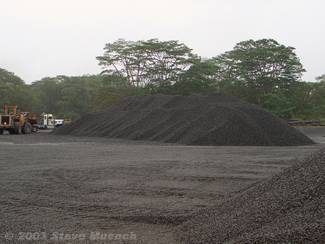 |
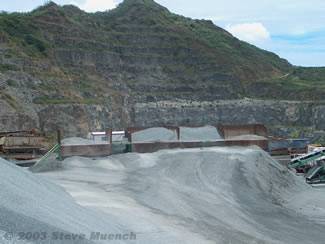 |
| Figure 1: Aggregate Stockpiles | Figure 2: HMA Plant Aggregate Feed Bins |
Aggregate Origins and Production
Aggregates can either be natural (Figures 3, 4 and 5) or manufactured. Natural aggregates are generally extracted from larger rock formations through an open excavation (quarry). Usually the rock is blasted or dug from the quarry walls then reduced in size using a series of screens and crushers. Some quarries are also capable of washing the finished aggregate. Manufactured rock typically consists of industrial byproducts such as slag (byproduct of the metallurgical processing – typically produced from processing steel, tin and copper) or specialty rock that is produced to have a particular physical characteristic not found in natural rock (such as the low density of lightweight aggregate).
Figure 3: Kapa'a Quarry
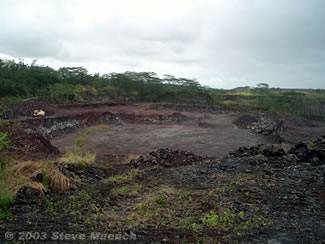 |
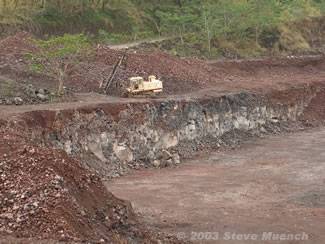 |
|
Figures
4 and 5: Yamada & Sons Quarry on the Big Island Near
Hilo |
|
Aggregate Physical Properties
Aggregates can be classified by their mineral, chemical and physical properties. The pavement industry typically relies on physical properties for performance characterization. An aggregate's physical properties are a direct result of its mineral and chemical properties.
Maximum Size
Maximum aggregate size can affect HMA and base/subbase courses in several ways. In HMA, instability may result from excessively small maximum sizes; and poor workability and/or segregation may result from excessively large maximum sizes (Roberts et al., 1996). ASTM C 125 defines the maximum aggregate size in one of two ways:
- Maximum size. The smallest sieve through which 100 percent of the aggregate sample particles pass. Superpave defines the maximum aggregate size as "one sieve larger than the nominal maximum size" (Roberts et al., 1996).
- Nominal maximum size. The largest sieve that retains some of the aggregate particles but generally not more than 10 percent by weight. Superpave defines nominal maximum aggregate size as "one sieve size larger than the first sieve to retain more than 10 percent of the material" (Roberts et al., 1996).
It is important to specify whether "maximum size" or "nominal maximum size" is being referenced.
Gradation
An aggregate's particle size distribution, or gradation, is one of its most influential characteristics. In HMA, gradation helps determine almost every important property including stiffness, stability, durability, permeability, workability, fatigue resistance, frictional resistance and resistance to moisture damage (Roberts et al., 1996). Because of this, gradation is a primary concern in HMA mix design and thus most agencies specify allowable aggregate gradations.
Measurement
Gradation is usually measured by a sieve analysis (see Figures
6 and 7). In a sieve analysis, a sample of dry aggregate of
known weight is
separated through a series of sieves with progressively smaller
openings.
Once separated, the weight of particles retained on each
sieve is measured and compared to the total sample weight.
Particle
size distribution is then expressed as a percent retained
by weight on each sieve size. Results are usually expressed
in
tabular or graphical format. The typical graph uses the
percentage of aggregate by weight passing a certain sieve
size on the
y-axis and the sieve size raised to the nth power (n =
0.45 is typically used) as the x-axis units. The maximum
possible density appears on a graph like this as
a straight line from zero to the maximum aggregate size (the
exact location of this line is somewhat debatable,
but the location shown in Figure 4 is generally accepted).
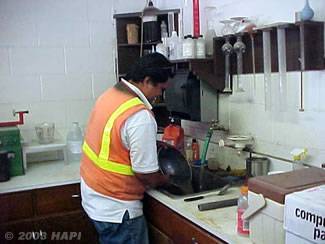 |
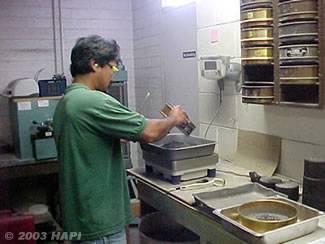 |
| Figure 6: Washing the Aggregate Before a Sieve Analysis | Figure 7: Weighing Aggregate During a Sieve Analysis |
Typical Gradations (see Figure 8)
- Dense or well-graded. Refers to a gradation that is near maximum density. The most common HMA mix designs in the U.S. tend to use dense graded aggregate.
- Gap graded. Refers to a gradation that contains only a small percentage of aggregate particles in the mid-size range. The curve is near-horizontal in the mid-size range. These mixes can be prone to segregation during placement.
- Open graded. Refers to a gradation that contains only a small percentage of aggregate particles in the small range. This results in more air voids because there are not enough small particles to fill in the voids between the larger particles. The curve is near-horizontal and near-zero in the small-size range.
- Uniformly graded. Refers to a gradation that contains most of the particles in a very narrow size range. In essence, all the particles are the same size. The curve is steep and only occupies the narrow size range specified.
Figure 8: Typical Aggregate Gradations
(Examples
are shown for 3/4-inch maximum aggregate size)
Other Gradation Terms
-
Fine aggregate (sometimes just referred to as "fines"). Defined by AASHTO M 147 as natural or crushed sand passing the No. 10 sieve and mineral particles passing the No. 200 sieve.HAPI Pavement Note on Fine/Coarse Aggregate HDOT defines fine aggregate as that portion that passes a No. 4 sieve. HDOT defines coarse aggregate as that portion that is retained on a No. 4 sieve.
- Coarse aggregate. Defined by AASHTO M 147 as hard, durable particles or fragments of stone, gravel or slag retained on the No. 10 sieve. Usually coarse aggregate has a toughness and abrasion resistance requirement.
- Fine gradation. A gradation that, when plotted on the 0.45 power gradation graph, falls mostly above the 0.45 power maximum density line. The term generally applies to dense graded aggregate.
- Coarse gradation. A gradation that, when plotted on the 0.45 power gradation graph, falls mostly below the 0.45 power maximum density line. The term generally applies to dense graded aggregate.
- Mineral filler. Defined by the Asphalt Institute as a finely divided mineral product at least 65 percent of which will pass through a No. 200 sieve. Pulverized limestone is the most commonly manufactured mineral filler, although other stone dust, silica, hydrated lime, portland cement and certain natural deposits of finely divided mineral matter are also used (Asphalt Institute, 1962).
Other Properties
Other important aggregate physical properties are:
-
Toughness and abrasion resistance. Aggregates should be hard and tough enough to resist crushing, degradation and disintegration from activities such as manufacturing, stockpiling, placing and compaction.
-
Durability and soundness. Aggregates must be resistant to breakdown and disintegration from weathering (wetting/drying) or else they may break apart and cause premature pavement distress.
-
Particle shape and surface texture. Particle shape and surface texture are important for proper compaction, load resistance and workability. Generally, cubic angular-shaped particles with a rough surface texture are best.
-
Specific gravity. Aggregate specific gravity is useful in making weight-volume conversions and in calculating the void content in compacted HMA (Roberts et al., 1996).
-
Cleanliness and deleterious materials. Aggregates must be relatively clean when used in HMA. Vegetation, soft particles, clay lumps, excess dust and vegetable matter may affect performance by quickly degrading, which causes a loss of structural support and/or prevents binder-aggregate bonding.
HAPI Pavement
Note on Hawai'i Aggregates |
In general, Hawai'i is blessed with fairly high quality aggregate. Certain sources do, however, produce aggregate with high absorption (this can lead to the aggregate absorbing excess asphalt binder, which may lead to stripping or raveling). Aggregate from a'a deposits is generally avoided because it tends to be high in voids and low in durability and toughness. |


